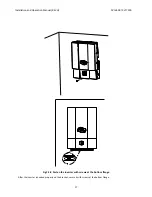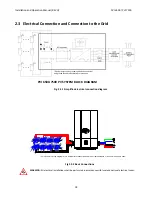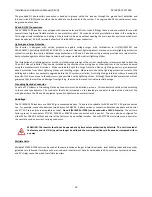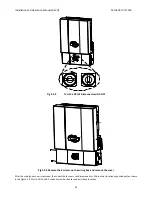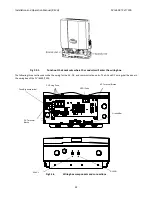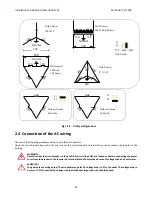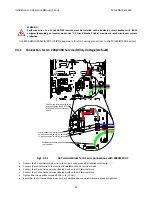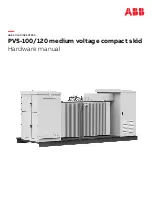
Installation
and
Operation
Manual
(REV
H)
PVI
6500
/
PVI
7500
10
2
Installation
WARNING:
Before
installing
the
PVI
6500
‐
7500,
read
all
instructions
and
caution
markings
in
this
manual
and
on
the
PVI
6500
‐
7500
as
well
as
those
written
on
the
photovoltaic
modules.
WARNING:
Electrical
installation
shall
be
performed
in
accordance
with
all
local
and
national
electrical
codes.
WARNING:
Connecting
the
PVI
6500
‐
7500
to
the
electric
utility
grid
must
only
be
performed
after
receiving
prior
approval
from
the
utility
company
and
installation
completed
only
by
qualified
personnel/licensed
electrician(s).
2.1
Checking
for
Shipping
Damage
The
PVI
6500/7500
inverters
are
thoroughly
inspected
and
tested
rigorously
before
they
are
shipped.
Even
though
they
are
delivered
in
a
rugged,
heavy
cardboard
box
with
foam
inserts,
the
inverters
can
be
damaged
in
shipping.
Please
inspect
the
inverter
thoroughly
upon
delivery.
If
any
damage
is
discovered
please
notify
the
shipping
company
immediately.
If
there
is
any
question
about
potential
shipping
damage,
contact
Solectria
Renewables.
A
photo
of
the
damage
may
be
helpful.
Solectria
Renewables
is
not
responsible
for
shipping
damage.
A
claim
must
be
filed
with
the
shipping
company.
Solectria
Renewables
will
assist
you
with
this
process
as
needed.
Do
not
accept
the
unit
if
it
is
visibly
damaged
or
if
you
note
visible
damage
when
signing
shipping
company
receipt.
Do
not
remove
the
unit
from
packaging.
If
it
is
determined
that
the
unit
must
be
returned,
an
RMA
number
must
be
obtained
from
Solectria
Renewables.
2.2
Inverter
Mounting
The
PVI
6500/7500
inverter
is
comprised
of
a
sealed
NEMA
3
corrosion
resistant,
painted
aluminum
enclosure
containing
all
electrical
and
electronic
components.
NOTE:
If
the
PVI
6500/7500
is
mounted
outside,
during
the
installation
process
and
in
case
of
rain,
do
not
open
the
inverter.
Notes
regarding
mounting
and
placement
of
the
inverter
Criteria
for
inverter
mounting:
Because
the
inverter
is
in
a
NEMA3
enclosure,
the
inverter
can
be
mounted
outdoors.
The
longest
inverter
life
can
be
achieved
by
mounting
it
in
a
clean,
dry
and
cool
location.
It
is
recommended
to
keep
the
unit
out
of
direct
rain
or
snow.
Protection
by
a
roof
overhang
or
covering
is
recommended
if
outdoor
mounting
is
necessary.
For
optimal
electrical
efficiency,
use
the
shortest
possible
AC
and
DC
wires
and
use
the
maximum
allowable
wire
size.
Avoid
installation
in
close
proximity
to
people
or
animals,
as
there
is
a
small
amount
of
high
‐
frequency
audible
switching
noise
emitted.
Install
the
inverter
in
an
accessible
location
following
local
codes.
Note
that
code
requirements
for
clearances
and
proximity
to
other
equipment
and
building
walls
apply.
Installation
at
eye
level
allows
easy
reading
of
the
indicator
LEDs
and
the
LCD
display.
For
optimal
inverter
life
and
performance,
do
not
mount
the
inverter
in
direct
sunlight,
especially
in
hot
climates.
If
the
unit
must
be
mounted
in
direct
sunlight,
a
silver
or
white
metal
sun
‐
shield
is
highly
recommended.
It
is
further
recommended

















